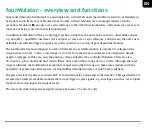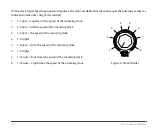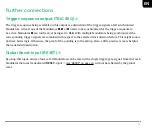
7
EN
The Modulators’ control elements
The four Modulators are built identically, so we will describe identical functions just once, while we will describe
the differences in synchronization and phase shift separately.
WAVE selector
q
The six-stage
WAVE
knob
q
selects the desired wave form. Available are ascending saw tooth (
S
), descending
saw tooth (
s
), square (
r
), triangle (
t
), sine (
i
) and random (
z
= sample & hold).
SPEED- and SPEED/PHASE controls
w
The
SPEED
control
w
adjusts the Modulators’ frequency.
SPEED
w
covers a range from 0.05 Hz to 100 Hz.
Therefore, modulations with audible frequencies are only possible within limits. The fourMulator’s focus within
the sub audio range is intended because higher frequencies would not make sense for use of the unit as clock-/
trigger-generator or for reciprocal modulations.
For Modulator
q
, the
SPEED
control
w
is limited to this function. For Modulators
w
,
e
and
r
, this control can
also shift the phase of the selected wave form when being synchronized to the left neighboring unit (
SYNC
switch
e
set to left position, see "SYNC switch" on page 9). Here, the Modulator being synchronized runs
with the same speed as the reference Modulator. Use
SPEED/PHASE
w
to adjust the phase of the wave for the
synchronized Modulator between
0° and 180°, shifting the wave form’s start-point
Summary of Contents for fourMulator
Page 1: ...User Guide fourMulator...


































